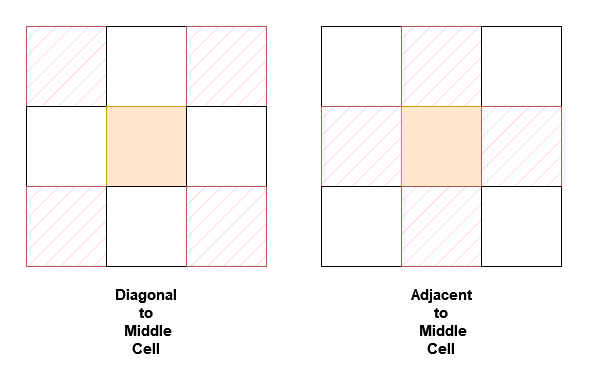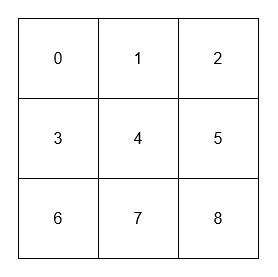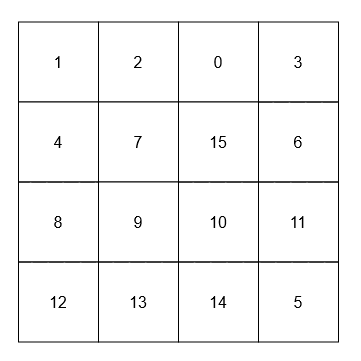Problem
ou are given a n x n 2D array grid containing distinct elements in the range [0, n2 - 1].
Implement the NeighborSum class:
NeighborSum(int [][]grid)initializes the object.int adjacentSum(int value)returns the sum of elements which are adjacent neighbors ofvalue, that is either to the top, left, right, or bottom ofvalueingrid.int diagonalSum(int value)returns the sum of elements which are diagonal neighbors ofvalue, that is either to the top-left, top-right, bottom-left, or bottom-right ofvalueingrid.

Example 1:
Input:
[“NeighborSum”, “adjacentSum”, “adjacentSum”, “diagonalSum”, “diagonalSum”]
[[[[0, 1, 2], [3, 4, 5], [6, 7, 8]]], [1], [4], [4], [8]]
Output: [null, 6, 16, 16, 4]
Explanation:

- The adjacent neighbors of 1 are 0, 2, and 4.
- The adjacent neighbors of 4 are 1, 3, 5, and 7.
- The diagonal neighbors of 4 are 0, 2, 6, and 8.
- The diagonal neighbor of 8 is 4.
Example 2:
Input:
[“NeighborSum”, “adjacentSum”, “diagonalSum”]
[[[[1, 2, 0, 3], [4, 7, 15, 6], [8, 9, 10, 11], [12, 13, 14, 5]]], [15], [9]]
Output: [null, 23, 45]
Explanation:

- The adjacent neighbors of 15 are 0, 10, 7, and 6.
- The diagonal neighbors of 9 are 4, 12, 14, and 15.
Constraints:
3 <= n == grid.length == grid[0].length <= 100 <= grid[i][j] <= n2 - 1- All
grid[i][j]are distinct. valueinadjacentSumanddiagonalSumwill be in the range[0, n2 - 1].- At most
2 * n2calls will be made toadjacentSumanddiagonalSum.
Solution
First attempt : Time complexity O(n2)
struct NeighborSum {
grid:Vec<Vec<i32>>
}
/**
* `&self` means the method takes an immutable reference.
* If you need a mutable reference, change it to `&mut self` instead.
*/
impl NeighborSum {
fn new(grid: Vec<Vec<i32>>) -> Self {
// println!("Grid {:?}", &grid);
let inst = NeighborSum {grid};
inst
}
fn adjacent_sum(&mut self, value: i32) -> i32 {
//println!("Ad value {} and self is {:?}", value, self.grid);
let mut output: i32 = 0;
let mut getindexofvalue: i32 = 0;
let mut vcount: i32 = 0;
for itemv in &self.grid{
let mut hcount: i32 = 0;
for item in itemv{
if(*item == value){
// println!("Found value {} == {} at column {}: row {}",item,value,vcount,hcount );
// letc calculate neighbours now
let mut leftitempointer:i32 = vcount - 1;
let mut rightitempointer:i32 = vcount + 1;
let mut topitempointer:i32 = hcount - 1;
let mut bottomitempointer :i32 = hcount + 1;
let mut leftitem :i32 = 0;
let mut rightitem :i32 = 0;
let mut topitem :i32 = 0;
let mut bottomitem :i32 = 0;
if(leftitempointer >= 0){
// println!(" left item hcount and leftitempointer are {} : {}",hcount,leftitempointer);
leftitem = self.grid[leftitempointer as usize][hcount as usize];
}
if(rightitempointer < itemv.len() as i32){
// println!(" right item hcount and rightitempointer are {} : {}",hcount,rightitempointer);
rightitem = self.grid[rightitempointer as usize][hcount as usize];
}
if(topitempointer >= 0){
// println!(" top item topitempointer and vcount are {} : {}",topitempointer,vcount);
topitem = self.grid[vcount as usize][topitempointer as usize];
}
if(bottomitempointer < self.grid.len() as i32){
// println!(" bottom item bottomitempointer and vcount are {} : {}",bottomitempointer,vcount);
bottomitem = self.grid[vcount as usize][bottomitempointer as usize];
}
output = leftitem + rightitem + topitem + bottomitem;
// println!("Output is {} {} {} {} {}", output, leftitem, rightitem, topitem, bottomitem);
}
hcount = hcount + 1;
}
vcount = vcount +1;
// println!("Adjecent value {} : {:?} : {:?}", value, itemv, self.grid);
}
// self.grid[0][0] = 3;
// println!("Ad value {} and self is {:?}", value, self.grid);
return(output)
}
fn diagonal_sum(&self, value: i32) -> i32 {
let mut output: i32 = 0;
let mut vcount: i32 = 0;
for itemv in &self.grid {
let mut hcount: i32 = 0;
for item in itemv {
if *item == value {
let top_left = if vcount > 0 && hcount > 0 {
self.grid[(vcount - 1) as usize][(hcount - 1) as usize]
} else {
0
};
let top_right = if vcount > 0 && hcount < (itemv.len() as i32 - 1) {
self.grid[(vcount - 1) as usize][(hcount + 1) as usize]
} else {
0
};
let bottom_left = if vcount < (self.grid.len() as i32 - 1) && hcount > 0 {
self.grid[(vcount + 1) as usize][(hcount - 1) as usize]
} else {
0
};
let bottom_right = if vcount < (self.grid.len() as i32 - 1) && hcount < (itemv.len() as i32 - 1) {
self.grid[(vcount + 1) as usize][(hcount + 1) as usize]
} else {
0
};
output = top_left + top_right + bottom_left + bottom_right;
}
hcount += 1;
}
vcount += 1;
}
output
}
}
/**
* Your NeighborSum object will be instantiated and called as such:
* let obj = NeighborSum::new(grid);
* let ret_1: i32 = obj.adjacent_sum(value);
* let ret_2: i32 = obj.diagonal_sum(value);
*/A freelance web developer with a decade of experience in creating high-quality, scalable web solutions. His expertise spans PHP, WordPress, Node.js, MySQL, MongoDB, and e-commerce development, ensuring a versatile approach to each project. Aadi’s commitment to client satisfaction is evident in his track record of over 200 successful projects, marked by innovation, efficiency, and a customer-centric philosophy.
As a professional who values collaboration and open communication, Aadi has built a reputation for delivering projects that exceed expectations while adhering to time and budget constraints. His proactive and problem-solving mindset makes him an ideal partner for anyone looking to navigate the digital landscape with a reliable and skilled developer.
